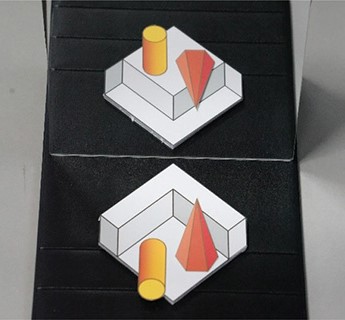Gibson, J. J. (1950). The perception of the visual world. Cambridge, MA: The Riverside Press. |
Gregory, R. L. (1970). The intelligent eye. London: Weidenfeld & Nicolson. |
Hoffman, D. D. (1998). Visual intelligence: How we create what we see. New York, NY Brockman Inc. |
Necker, L. A. (1832). Observations on some remarkable phenomena seen in Switzerland; and an optical phenomenon which occurs on viewing of a crystal or geometrical solid. Philosophical Magazine, 3rd series, 1, 329–337. Retrieved from https://www.tandfonline.com/doi/abs/10.1080/14786443208647909 |
Perkins, D. N. (1972). Visual discrimination between rectangular and nonrectangular parallelepipeds. Perceptual Psychology, 12, 293–331. Retrieved from https://link.springer.com/article/10.3758/BF03205849 |
Perkins, D. N. (1973). Compensating for distortion in viewing picture obliquely. Perceptual Psychology, 14, 13–18. Retrieved from https://link.springer.com/article/10.3758/BF03198608 |
Richards, W., & Miller, J. F., Jr. (1971). The corridor illusion. Perception & Psychophysics, 9, 421–423. Retrieved from https://link.springer.com/article/10.3758/BF03210243 |
Robinson, J. O. (1998). The psychology of visual illusion. Mineola, NY: Dover Publications. |
Shepard, R. N. (1990). Mind sights: Original visual illusions, ambiguities, and other anomalies with a commentary of the play of mind in perception and art. New York, NY: W. H. Freeman and Company. |
Sugihara, K. (2015a). Ambiguous cylinders: A new class of impossible objects. Computer Aided Drafting, Design and Manufacturing, 25, 19–25. |
Sugihara, K. (2015b). Height reversal generated by rotation around a vertical axis. Journal of Mathematical Psychology, 68–69, 7–12. doi: 10.1016/j.jmp.2015.07.001 |
Sugihara, K. (2016a). Anomalous mirror symmetry generated by optical illusion. Symmetry, 8, 21, doi: 10.3390/sym8040021 |
Sugihara, K. (2016b). A new type of impossible objects that become partly invisible in a mirror. Japan Journal of Industrial and Applied Mathematics, 33, 525–535. doi: 10.1007/s13160-016-0233-9 |
Sugihara, K. (2018). Topology-disturbing objects: A new class of 3d optical illusion. Journal of Mathematics and the Arts, 12, 1–17. doi: 10.1080/17513472.2017.1368133 |
Sugihara, K. (2020a). Ambiguous tiling. Computer Aided Geometric Design, 79, 101851. doi: 10.1016/j.cagd.2020.101851 |
Sugihara, K. (2020b). Family tree of impossible objects created by optical illusion. Bridges 2020 Conference Proceedings (pp. 329–336). Retrieved from http://archive.bridgesmathart.org/2020/bridges2020-329.pdf |
Sugihara, K. (2020c). 3D Schröder Staircase, First prize of the best illusion of the year contest 2020. Retrieved from http://illusionoftheyear.com/cat/top-10-finalists/2020/ |
Sugihara, K. (2021). Rising object illusion, top ten finalist of the best illusion of the year contest 2021. Retrieved from http://illusionoftheyear.com/cat/top-10-finalists/2021/ |
Sugihara, K. (2022). Rising object illusion. Journal of Mathematics and the Arts, 16(3), 232–243. doi: 10.1080/17513472.2022.2045047 |
Sugihara, K., & Pinna, B. (2022). Rectangularity is stronger than symmetry in interpreting 2D pictures as 3D objects. Frontiers in Human Neuroscience, 16, 849159. doi: 10.3389/fnhum.2022.849159 |




